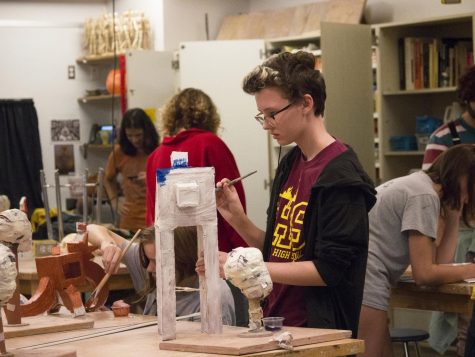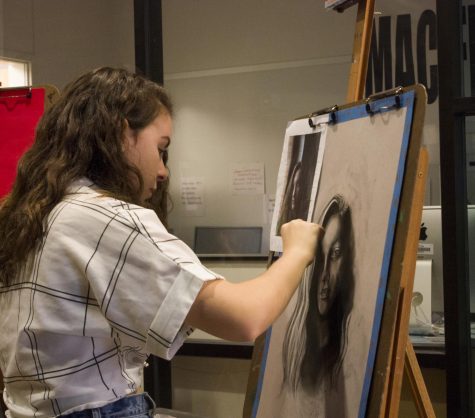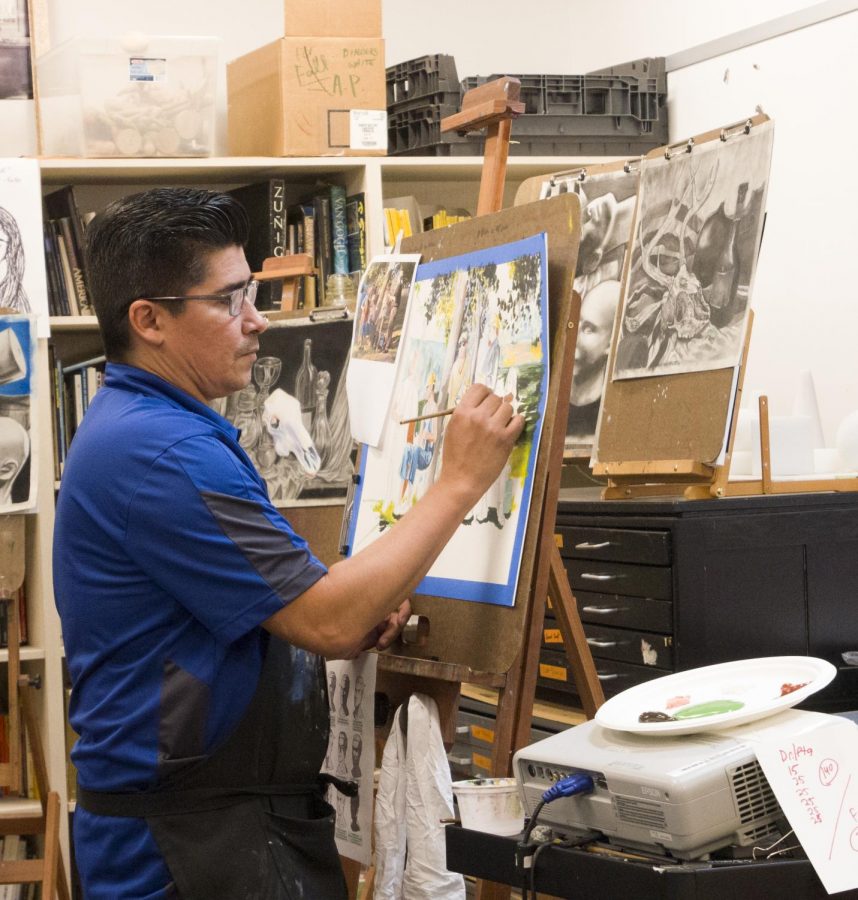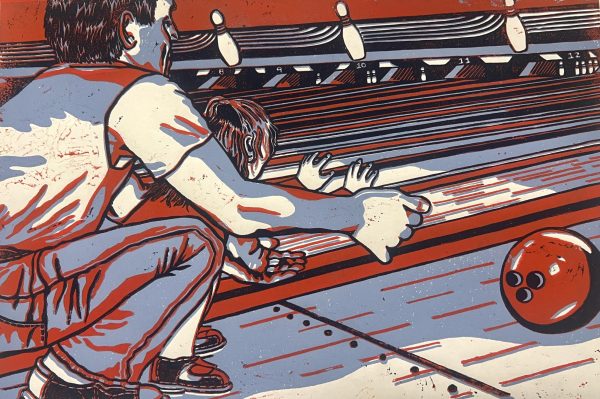Been there, done stacked
Record-high class sizes force teachers to teach multiple classes and multiple levels at same time
Mr. Martinez demonstrates acrylic painting techniques to his first-period Painting 1 students. The class contains students from Drawing II, Drawing III and Painting III spread throughout the room and hallway. “[This is] why we do stacked classes,” Martinez said. “So that students have choices about where they can go at different periods during the day.” Photo by Kristen Tibbetts.
October 19, 2018
Most teachers have enough distractions in their classroom to deal with: cellphones and overly talkative students to name a couple. But, for art teachers Carey West and Jeff Seckar-Martinez, they have to teach with multiple classes in the room at once.
For art teachers, “stacked” classes, class periods with multiple mediums and levels in the same room, are not out of the ordinary. In fact, they have long been necessary to ensure that students can fit the electives that they want into their schedule. This year, however, the art department is experiencing a greater number of students than ever before.
“[It] gets kind of challenging when you have limited space and supplies,” Martinez said. “But [I] try to do the best that I can to benefit all [of my] students.”
Martinez’s biggest class—a mixture of Drawing II, Drawing III, Painting III and AP Portfolio—has 36 students, and his average class size is around 30 students. This may not seem like a lot, but the number puts a considerable strain on the available materials and classroom space.
“It just gets more challenging to fit the amount of bodies in this space,” Martinez said. “We’ll be working in the hallways probably and we’ll have easels and different sizes of paper and surfaces for them to make it all work.”
We’ll be working in the hallways probably, and we’ll have easels and different sizes of paper and surfaces for them to make it all work.
— art teacher Jeff Seckar-Martinez
Due to a lack of space and a high demand for art classes, Martinez decided not to accept any student aides in any of his classes.
“It was hard for me to do that,” Martinez said. “[But] it was just taking up seats for people who wanted to learn art.”
Ms. West, however, has had a different experience. For the first time this year she is teaching both sculpture and jewelry in the same class period.
“They’re completely different, and they’re both kind of new to me,” West said, “so managing that is a little tricky.”
Usually in a stacked class, students work with the same medium but at different levels. To conduct her sculpture-jewelry class, however, West has to teach two completely different curriculums at the same time.
“I kind of flip-flop my time,” West said. “I try to get students working independently on something in one group and then address the next group.”
The classroom is arranged with jewelry students working at the tables near the front of the room and sculpture students working on their projects in the back.
“I was expecting a lot of chaos, it being an art class [and all],” freshman sculpture student Zara Terrazas-Graham said, “but it has actually turned out really well.”

For West, the hardest part is having to keep up with many different Blend accounts and gradebooks. Unlike Martinez, she still accepts student aides in her classes, which brings her total number of gradebooks to 16.
“It’s like juggling.” West said.
Even with the distractions of multiple classes and levels in one period, West and Martinez have made sure to not let it take away from each student’s learning experience.
I try to get students working independently on something in one group and then address the next group.
— art teacher Carey West
“The skill sets [in my classes] are very different,” Martinez said, “but the goal is to get them all to show their own personal vision.”
In fact, sometimes the stacked classes work in students’ favor. West has noticed, particularly in her stacked ceramics classes, that the more advanced students have been able to help instruct some of the newer artists.
Even with the benefits, of course, the teachers fear that newer students might be overwhelmed by the pace at which the class runs.
“Our classes are not just places where people can get thrown in,” Martinez said. “Prerequisites are very important. [The students] learn other skills based on what they learned in the past.”
As far as what the future will hold, neither teacher believes this system is the best fit for the long run. McCallum’s student population has grown every year for the past four years, and is expected to continue growing in the future.
“If anything, we don’t want to turn people away,” Martinez said, “but ideally we would have more space.”

While more space for art classrooms will not be available any time soon, art teachers have been thinking of other possible solutions.
“I think offering more electives might be an option,” Martinez said. “It’s great that people take the art classes, but some people [just] take art [because] they need a place to go. If we had other classes available, they could go in that direction, too.”
Even with multiple periods of stacked classes, some students, particularly the Fine Arts Academy majors who have to take three art classes as part of their major requirements, still have trouble getting into their preferred classes.
“They just have to make choices at that point.” Martinez said. “We can’t just open up a new section for someone to come in.”
With more and more students each year enrolling in art classes, the teachers are hoping to offer even more new mediums, such as digital art, in the near future to cater to students with specific artistic interests.
“I think there’s just a lot of need for electives and art happens to be popular,” West said. “Because it’s fun!”

















Andrew • Nov 6, 2018 at 9:55 am
I like this article, but I think it focuses a little much on the opinions. It does give both sides, which I am glad of, but I think it would be cool if the article went a little more in-depth of the backgrounds and specific experiences of the students and teachers interviewed.
. • Nov 6, 2018 at 9:39 am
I personally am in a stacked class, and I agree that it’s more difficult, but Mr. Martinez does an amazing job at making it feel like a normal classroom and teaching each class fully.